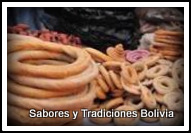
El calendario gastronómico de La Paz de antaño
SABOR Muchos platos representativos y los acompañamientos que se servían a la hora del almuerzo, en fechas especiales, durante la Colonia, se mantienen hasta la actualidad.
Artículo escrito por Alejandra Pau / La Paz – 28/06/2011
Desde la Colonia y hasta las primeras décadas del siglo XX, las cocinas de las familias paceñas estaban ubicadas por lo general en un patio interior de las casas. Allí se cocinaba con un fuego avivado por la taquia, excremento de llama, mientras que lo más parecido a un refrigerador era el cuarto más fresco que por tradición debía estar ubicado frente al Illimani.
Después de haber rezado El Ángelus, al toque de las tres campanadas, a mediodía se almorzaba, puntualmente, en los hogares paceños. Platos que ahora son parte de la llamada “comida típica nacional” eran servidos con regularidad.
El menú cotidiano contemplaba el thimpu, costillar o guiso; además la warjata, ranga, fritanga, entre otros; todos acompañados por plátano cocido, putis de chuño, tunta o kaya, un cocido o mezclado del tubérculo con queso, huevo o maní.
En lugar del pan, la familia se servía de una fuente de habas phuspu -habas secas cocidas-, mote de habas o de maíz.
Pero también existía un calendario gastronómico establecido que respetaba la fuerza de la tradición, y que mandaba a servir ciertos platos sólo en fechas especiales. La costumbrista Elizabeth de Col ha investigado y rescatado muchos detalles que guardan la esencia de los sabores más representativos, muchos de los cuales se mantienen en la actualidad.
Enero
Entre la noche vieja y el primer día de un nuevo año se consumían platos basados en carne de cerdo, como el chancho al horno o el tradicional fricasé. “Algunos festejaban hasta la hora del phosko allpi de la mañana, lo que hoy conocemos como api”, dice De Col.
El 24 de enero, en la fiesta de Alasita, se comía el tradicional plato paceño, sin carne, pero en grande y en chiquito. La versión en miniatura estaba a cargo de los más pequeños de la casa, para lo que adquirían quesos en las aljerías, lugares donde los hacendados vendían productos que producían en sus fincas.
El plato paceño surgió del cerco a La Paz que en 1781 protagonizó Tupac Katari, y que dejó a la ciudad aislada por tres meses.
“En las casas se sembraba papa, haba y choclo, y por ello surge este plato, aunque otra versión dice que al terminar el cerco los agricultores de Río Abajo llegaron a comercializar estos tres productos, además del queso”, comenta la costumbrista.
Febrero
El domingo de carnaval se llevaba lechones o lechoncitos a los hornos de los barrios.
En lunes de carnaval no podía faltar el picante surtido con tunta achuta (con queso) y “sarsa” compuesta por cebolla picada, tomate y locoto, que podía llevar también arveja cocida -y donde también surgió la sajta de pollo-. También estaba el ají de lengua, estirado de conejo, saice, ranga, tortilla de cola de cebolla, entre otros.
Para el martes, día de la ch’alla, se consumían todos los productos que daba la tierra representados por el puchero, que contenía pecho de vaca, espalda de cordero, tocino, chorizo, repollo, zanahoria, garbanzo, papa, racacha, yuca y arroz.
El miércoles de ceniza se disfrutaba de las humintas en tradicionales días de campo, además de mucha fruta.
El viernes de Cuaresma se consumía el tradicional “caldo de viernes”, hecho de verduras, leche y huevo. El segundo consistía en suchis, karachis y otros pescados del lago Titicaca, pero también se podía optar por el ají de papalisa, queso humacha y ají de huevos.
Marzo
El 3 de marzo, día de la Cruz, se comía la huatía, hecha con carne de cordero, ocas, papas y camotes. “Y era tradición decir 1.000 veces Jesús contando maíz”, comenta sonriendo la costumbrista.
Abril’
Semana Santa y Pascua
En Semana Santa, especialmente el jueves y el viernes, era tradicional consumir bacalao, cochayuyo, caldillo de camaroncillos, ají de arvejas, llullucha y para el postre compota de frutas y arroz con leche.
No obstante, ya para la Pascua mandaban en el menú el cordero o el chancho.
Mayo y Junio
Entre los últimos días de mayo y los primeros de junio, dependiendo de calendario eclesiástico, se celebra el Corpus Christi. En esa fecha, en el campo, se mataban ovejas hembras o corderos viejos.
Sólo sus menudencias llegaban a La Paz, por lo que se preparaban platos como la wilapara -una especie de morcilla hecha de la sangre de ese animal-, chanfaina de panza y ají de sullu -de fetos de oveja-.
También era tradicional comer la chokopa, más que en otras fechas, una mezcla de maní, melcocha, naranja, mandarina, ajipa y pepino.
Julio
Los primeros días de julio llegaba la khumunta, y los empleados de las fincas regresaban con las cosechas y con cerdos de gran tamaño llamados k’uras para preparar platillos como chicharrón, fricasé, warjata o fritanga.
“Era un día de solidaridad porque llegaban grandes cantidades de productos, pero no sólo se favorecía a quien podía adquirirlos, ya que se veía a los empleados de las casas llevando una parte a los hospicios, hospitales y asilos. También eran beneficiados los inquilinos, ex arrenderos y los familiares pobres o que no tuvieron buena cosecha”, explica De Col.
El chairo era un plato que se consumía a diario. Surgió por la khumunta, ya que los restos que quedaban, como el chuño más pequeño, la tunta más menuda, el cebo de la chalona, la pepa del ají o huaicachira eran regalados a los pongos, quienes los mezclaban con otros condimentos creando así el jintimanka, que en su versión refinada no es otra cosa que el chairo.
Agosto
Para el 16 de julio y el 6 de agosto se preparaba lechón o platos también con carne de chancho y se realizaban las verbenas, animadas por el té con té y sucumbé, mientras se observaban las procesiones ecuestres.
Noviembre
Llega Todos Santos. Mandaba el ají de arvejas y las “frutas secas”, y también masitas como las empanadas de queso, alfajores, maicillos y bizcochuelos. No podían faltar las tanthawawas, tantha caballos, escaleras, cañas y demás masitas.
Diciembre
El 24 de diciembre, en Noche Buena, era y sigue siendo infaltable en las mesas paceñas la picana con carne de cordero, pollo y vaca, con tunta, choclo, papa, entre otros.
“Antes, la picana se hacía en una olla de barro grande. Se juntaba lo que quedaba de las botellas del vino con papa, nabo, pimienta blanca, las carnes, zanahoria, pasas y hojas de laurel. Se tapaba con una chua y encima de la olla una masa de pan que cubría todo para luego mandarla al horno”, recuerda la costumbrista.
Las cocinas del pasado
Cocina La cocina de antaño se instalaba en un gran ambiente, donde funcionaban las cocinas económicas con dos o más hornillas, que se alimentaban con taquia, excremento de llama, también un brasero alimentado con carbón.
Más detalles Una cocina no estaba completa sin los peroles de cobre, mesas forradas con lata, calentador de agua, wisllas -cucharas de madera.
Desayuno El desayuno de antaño consistía en té o café; sólo los niños tomaban leche.
Más comida El té no era relevante, pero a las 18:00 toda la familia tomaba un caldo muy ligero de avena o sémola, por lo general, y un ají de acelga, fideo y otros.
Chocolate Luego de las tertulias, se bebía chocolate con bizcochos.
La Razon
Artículo escrito por Alejandra Pau / La Paz
Etiquetas: Bolivia, Calendario, Gastronomico, Historia, La Paz, Tradicion



![[Suma Phayata]](https://i0.wp.com/comosur.com/wp-content/uploads/2014/09/Anticucho-1024x680.jpg)
![[Suma Phayata]](https://i0.wp.com/comosur.com/wp-content/uploads/2014/09/Anticucho-solo-300x276.jpg)
![[Suma Phayata]](https://i0.wp.com/comosur.com/wp-content/uploads/2014/09/Sandwich-Chorizo-300x199.jpg)
![[Suma Phayata]](https://i0.wp.com/comosur.com/wp-content/uploads/2014/09/Sandwich-Chola-300x199.jpg)



















 Quiero darte las gracias de nuevo por haber pensado en mi para este premio. Los invito a visitar el blog de Marina, que estoy segura les gustara y sera de mucha utilidad para conservarse saludables.
https://consejonutricion.wordpress.com
Quiero darte las gracias de nuevo por haber pensado en mi para este premio. Los invito a visitar el blog de Marina, que estoy segura les gustara y sera de mucha utilidad para conservarse saludables.
https://consejonutricion.wordpress.com





